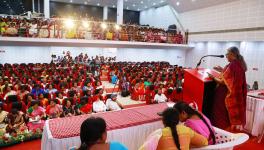COVID-19 in Rural India-XXXVIII: Haryana Farmers Under Distress Due to Labour Shortage and Delay in Harvesting

Representational image. | Image Courtesy: Wikipedia
This is the 38th report in a series that provides glimpses into the impact of COVID-19-related policies on life in rural India. The series, commissioned by the Society for Social and Economic Research, comprises reports by various scholars who have been conducting village studies in different parts of India. The reports have been prepared on the basis of telephonic interviews with key informants in their study villages.
This report presents the impact of the lockdown on three villages in Haryana: (i) Chehar Kalan located in Bhiwani district; (ii) Khandrai in Sonipat district; and (iii) Jamalpur Shekhan in Fatehabad district.
Chehar Kalan
The major agricultural crops grown here are wheat and mustard in the rabi season and cotton, bajra and guar in the kharif season. The population of Chehar Kalan includes Jat, Khati, Dhanak, Chamar, Baniya, Kumhar, Brahman, and Nai caste groups. Jats are the socio-economically dominant caste group and own most of the agricultural land. Chamar and Dhanak households belong to the Scheduled Caste category and are either landless or own very small parcels of land; individuals from these households mostly work as casual labourers in both agricultural and non-agricultural activities. Workers from landless and small land-owning households are often engaged by big landlords in the village on long-term labour contracts. This type of contract is called the siri or the muzara system. Under it, a worker (muzara), usually along with other members of their household, carries out agricultural operations on part of the landlord’s fields. In return, the long-term worker receives a share of produce. The muzara may also be required to share a part of the material costs of production. The proportion of the costs borne and produce earned varies considerably within the village and depends on the land type, availability of irrigation and social relations between the muzara and the landlord. While the muzara provides all the labour required for production, all decisions with regard to the crops—including what will be sown, the inputs to be used and where and how the produce will be sold—are taken by the landowner.
Khandrai
The main crops grown here are wheat, paddy, cotton, and sugarcane. The village’s inhabitants include Chamars, Dhanaks, Jats, Jhimars, Kumhars, and Khatis. The villagers are engaged in casual agricultural labour as well as various kinds of casual non-agricultural work such as construction, loading/unloading and livestock-keeping. A number of workers from here also commute 5 km to Gohana town for work.
Jamalpur Shekhan
Wheat is the major rabi crop in the village, while paddy and cotton are cultivated in the kharif season. Mehta and Jaat Sikh households are the major landowning caste groups followed by Kamboj households (Backward Caste). Many Backward Caste households belonging to the Saini caste group also own small areas of land. Households that belong to the Odh, Chamar and Bazigar communities (Scheduled Caste) are landless. Farming and animal husbandry are the major occupations of the landowning households while individuals from landless households mainly work as casual wage labourers. Many adult individuals from landless households also go to the nearby town of Tohana for work.
Impact on agriculture
When the COVID-19 induced nationwide lockdown was first imposed, the fully mature standing wheat crop was ready for harvesting. The harvesting of wheat in these villages is done both manually and using combine harvesters. Small farmers prefer manual harvesting because they use the dry fodder that is left to feed their animals. The quality of fodder is degraded and the quantity per acre is reduced in mechanised harvesting. Large-scale and medium-scale peasants mainly use combine harvesters but they, too, harvest a small part of their land manually in order to acquire sufficient fodder for their own livestock. Migrant workers from Rajasthan, Uttar Pradesh and Bihar usually make up the majority of agricultural labour hired during the wheat harvesting period. However, the lockdown prevented migrant workers from travelling to Haryana this season, and this created an acute shortage of agricultural labour in the three villages.
In Chehar Kalan, all agricultural work was delayed by about 25 days due to the lockdown. At the beginning of the lockdown, farmers were not allowed to undertake any agricultural operations, including harvesting. This restriction was later relaxed. Untimely rain and wind before the harvest damaged the wheat crop, causing the plants to collapse (a phenomenon called ‘lodging’). This made harvesting using machines difficult, which further drove up demand for agricultural workers. The lack of agricultural labour was partially offset by the availability of casual non-agricultural wage workers who are unemployed due to the lockdown. However, even this has not been enough to meet demand. The shortfall has also pushed up wage rates for agricultural work in Chehar Kalan during the lockdown. While migrant workers in the past received two quintals of wheat per acre for harvesting and bundling, workers are now being paid two-and-a-half to three quintals of wheat per acre for the same operations. The piece rate for a group of labourers engaged in threshing has also increased from Rs 1,500 to Rs 3,000 per acre.
While the labour shortage and high wage rates have posed difficulties for small and medium-scale farmers, big farmers in Chehar Kalan have not faced the same issues because the muzara system has ensured they have access to labour. When the restriction on agricultural activities during the lockdown was lifted, the muzaras were able to work. However, unlike other agricultural workers who have benefited from a transient rise in wages, there has been no corresponding rise in the share of the produce paid to the muzaras.
In Khandrai, casual non-agricultural wage workers took up agricultural work during the harvesting period. There has been no rise in the amount of grain given to labourers for harvesting and threshing, but the wage rate for other work such as loading/unloading has increased from Rs 500 to Rs 700 per day. Many farmers here use combine harvesters that come from Punjab during the harvest season every year. Respondents from Khandrai reported that, this year, the arrival of the combine harvesters was delayed by about 20 days due to the lockdown. This meant that fully ripened wheat remained standing in the fields during this time, and the labour needed for manual harvesting was not available. Despite the delay in their arrival, the rental rates for agricultural equipment and machines remained unchanged.
In Jamalpur Shekhan, untimely rain before the wheat harvest and the looming prospect of loss if harvest-ready crops were left in the fields forced farmers to hire locally available harvesting machines. This has led to a fall in the amount of dry fodder per unit of cultivated land. There has been no change in the wage rates for workers in the village.
The delay in harvest of the rabi crop has led to a delay in the sowing of cotton by 20-25 days this year, farmers would ideally have started sowing cotton by the April 15. Farmers also apply manure to their fields after the rabi crop has been harvested in order to enhance the soil’s nutrient content. The delay in the completion of the harvest has forced them to abandon this process. One respondent in Chehar Kalan, who is waiting for his fields to get cleared so that he can start sowing cotton, said that this could lead to a 30-40% fall in crop yield.
Small farmers typically take their produce directly to the mandis from the fields to sell it immediately after harvesting. However, the closure of the mandis during the lockdown compelled them to store their produce, either in the fields, or in their homes. The mandi for Jamalpur Shekhan became operational in the first week of May and that for Khandrai in the second week of May. But the imposition of new restrictions to regulate the number of people allowed in the mandi at a particular time has meant that most farmers are still awaiting their turns to take their produce to the mandis. In order to achieve social distancing, commission agents are allowed to procure only four to five trolleys of wheat per day. In Chehar Kalan, the government set up a temporary mandi in the common area of the village. This began operating on May 15, and has finally kick-started the process of public procurement of foodgrains.
During the lockdown period, shops that sell agricultural inputs that have been permitted to remain operational for certain fixed hours every day. They are presently selling agricultural inputs at a mark-up of 10-20% over MRP.
The inability to sell their produce and the increased cost of inputs have been sources of anxiety for many farmers, especially small and medium-scale farmers. Many now do not have the cash needed to purchase inputs for the kharif season.
Impact on the livestock economy
Managing livestock and selling of milk are important economic activities in all three villages. A large number of small and medium-scale farmers engage in animal husbandry to supplement their farm income. During the lockdown, people with livestock have found it difficult to arrange for feed for their animals. Shops that sell feed are open only for three to four hours a day and are selling their products at much higher prices.
In all three villages, the price of cattle feed has increased after the lockdown. For example, the price of khal (cotton seed cake) has increased by Rs 500 to 600 per quintal. While the cost of cattle feed has gone up, the price of milk has decreased in both Chehar Kalan and Jamalpur Shekhan. During the first 20-25 days of the lockdown, the procurement of milk fell significantly in both villages. In Jamalpur Shekhan, milk used to be procured at the rate of Rs 75/l, but this fell to Rs 50/l during the lockdown. This was still the case in the first week of May. In Chehar Kalan, a private dairy and a cooperative dairy procure most of the milk produced in the village. During the lockdown, procurement fell and so did the milk price, from Rs 60 to Rs 50 per litre. Procurement by the dairies has improved after the second week of April, but the price is still lower than it used to be before the lockdown, by Rs 3 or 4.
In Khandrai, there has been no disruption in the procurement and supply of milk in the village because it is mainly sold within the village itself. During the lockdown period, the village milkman continued to procure and distribute milk in the village at the same price as before.
Impact on non-agricultural work
All non-agricultural work has come to a complete halt in the three villages. As a result, labourers who were engaged in non-farm activities suddenly found themselves out of work. Harvest work in the villages was a source of employment for casual wage workers in Chehar Kalan and Khandrai. The amount of agricultural work available during the harvest season has provided these workers with a steady source of income during the lockdown. However, when the harvest season ends, they will once again be left without any work unless the lockdown is lifted. The sudden increase in wage rates noted above is also not likely to last beyond harvest season. In Jamalpur Shekhan, non-agricultural workers could not benefit from the harvest season as most of the harvesting was done using machines.
Workers in non-agricultural urban jobs have not been able to commute to work during the lockdown. There is uncertainty over whether their jobs still remain. A respondent from Khandrai used to work as a delivery boy in Gohana town. He received his salary till March, after which his contractor refused to pay him for April. The respondent reported that the prime minister's speech on TV requesting employers to pay full salaries to their employees during the lockdown encouraged him and two co-workers to request the contractor to pay them for April as well. All three of them were fired as a result.
Casual workers have not received any kind of financial help from the government and MGNREGA work ceased completely during the lockdown.
Impact on food prices and food security
There has been a significant rise in food prices in all three villages. The price of potatoes has more than doubled during the lockdown, and the prices of most green and leafy vegetables have increased by 20-30%. The price of mustard cooking oil has increased by 20-25%. Respondents in Khandrai reported that prices are relatively low in the nearby town (Gohana) but they cannot travel there due to the roads being blocked, and are thus forced to either buy items in the village at high prices or cut down on vegetable consumption. This hike in prices poses a major threat to the food security of the inhabitants of these villages.
Respondents in all three villages reported that ration-card holding households have received their regular share of food grains in March and April. By this time of year, most villagers have usually exhausted all their stock of grain and await the wheat harvest to stock up again. However, since all work had stopped because of the lockdown, people were dependent on the timely distribution of grain.
According to our respondents, no one in the three villages has as yet received the additional five kg of free food grains and one kg of pulses per person that were to be distributed to all households covered under National Food Security Act (NFSA) for a period of three months.
Packets of dry rations for children enrolled in government primary schools have been delivered to their homes by anganwadi workers in all three villages. Each packet contains one kg of wheat and two kg of rice for students at the primary level. The packets were only distributed in April.
It can be concluded that while people in the villages are aware of the severity of the pandemic and the precautionary measures that are required to prevent the spread of the virus, they are also concerned about their ability to earn an income to survive on. Our respondents reported that they will soon exhaust their meagre savings on purchasing food and other essential commodities during the lockdown.
Casual workers have benefited from the transitory rise in the wage rates brought about by the labour shortage during the crucial harvest period. However, as the harvest nears its end, this buoyancy in the labour market is likely to die down, and casual labourers will again be left with no work. Income and food support programmes will become crucial for their survival. In the absence of work and food support programmes, casual labourers might not possess the purchasing power to buy food.
[All three villages were surveyed in 2018 by a group of researchers and scholars from the Society for Social and Economic Research for a study on the agricultural practices and livelihoods of the inhabitants. This report is based on telephonic interviews conducted between 3 and 16 May 2020.]
Umesh Kumar Yadav is a researcher at Tricontinental: Institute for Social Research.
Vaishali Bansal is a research scholar at the Centre for Economic Studies and Planning, Jawaharlal Nehru University, New Delhi.
Get the latest reports & analysis with people's perspective on Protests, movements & deep analytical videos, discussions of the current affairs in your Telegram app. Subscribe to NewsClick's Telegram channel & get Real-Time updates on stories, as they get published on our website.
























